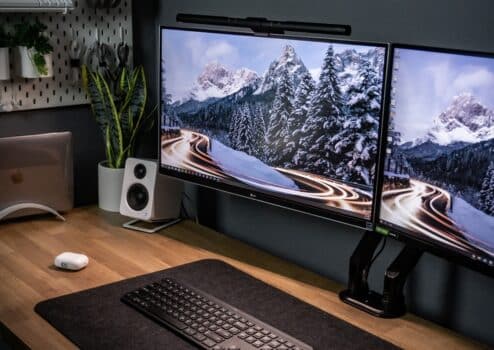Got an extra monitor lying in the basement? Why not put it to use with a dual monitor stand?
Pairing two well-functioning monitors will push your productivity and organizing skills up a notch. And if you’re a gamer, dual monitors can significantly enhance your gaming experience. However, to install two monitors at the preferred angle, you’ll require a dual monitor stand.
Unfortunately, a monitor stand, with its multiple adjustable parts, can cost more than the monitor itself, which is, in all honesty, insane! Hence, we’ve compiled this guide on a DIY monitor stand that won’t cost you an arm or a leg.
So, without any further delay, let’s get straight into the deets…
What Is A Dual Monitor Setup?

With a dual monitor setup, you can view and use two screens operating from a single computer. Almost all computers are able to handle two monitors, so creating such a setup can offer unlimited advantages according to the type of work you do.
Materials Required For Creating A DIY Monitor Stand
Before getting started with the process, make sure you have the following materials at hand…
- ¾-inch I.D. (⅞-inch O.D.) galvanized steel pipe
- Machine screws & nuts
- L-channel aluminum for joining pieces
- ¾-inch floor flange
- Wooden screws
- 2-inch PVC pipe for holding cables
- 4 mm diameter screws
- Felt furniture feet for floor flange
- Rivets
Additionally, we recommend creating a rough blueprint of how you would want to set up your DIY monitor stand. You could either mount it on your work desk or have it freestanding behind the desk. However, note that the method in this guide describes an almost freestanding dual monitor stand. The desk supports the structure to prevent any leaning and damage.
How To Make A DIY Desk Monitor Stand On A Budget?
Step 1
First and foremost, conduct a test assembly before attaching the parts permanently. Some DIYers swear by this method as certain materials (mentioned above) tend to be smaller or larger than you’d want. Accordingly, you may have to make adjustments by drilling.
Step 2
Paint the PVC pipe in your desired color. You can paint other parts too, but once the structure is ready, just the pipe will be visible. So, if you’re running short on time and patience, just paint the PVC pipe.
Step 3
Check that the metal pipe is long enough to keep the monitors at your eye level. Anything lower can add stress to your neck, which will be detrimental to your health in the long run.
Step 4
Attach the floor flange to the metal pipe, and then add the felt furniture feet to prevent scratches on the floor.
Step 5
Use the L-channel aluminum to join each piece together. You can also use an H-shaped extrusion profile of an old photo frame (that you no longer use). In fact, the latter may offer a better fit.
Step 6
Rivet the edges and remove the original monitor feet. Here, you must be patient and cautious not to break any parts.
Step 7
Mount the monitor and screw everything together tightly. The structure should be able to swivel a bit.
If the two monitors have some space left in between, you could use a plastic strip of the same color as a visual joiner. Though this is not a necessity, the tiny gap could bother some users.
How To Install A Dual Monitor Stand?
Once your DIY monitor stand is ready, installing it is a piece of cake. However, since different computers and monitors require different cables, here’s a list of the common types of cables you may need:
- DisplayPort
- VGA
- HDMI
- DVI
Steps To Install Dual Monitors
- Connect the second monitor to your computer and then to a power source.
- Select “Extend these displays” from your computer’s display settings.
- Select the primary display and the order of the monitors.
Why You Need A Dual Monitor Stand
1. Extra Desk Space And Cable Organization
This advantage of having a dual monitor stand is more apparent if the structure is freestanding. As such, you will have more space on your desk for other computer accessories, office supplies, etc.
Moreover, a dual stand keeps the cables off the floor, allowing you to keep your space more organized. You’ll also be preventing any chances of tripping over computer cables every now and then!
2. Better Posture And Less Eye Strain
If you’re an animator, digital artist, or simply a multitasker, you’d know how hard it is to maintain a good posture while staying in front of a screen for long hours. However, with a DIY monitor stand, you can keep the height according to your eye level. This will help maintain an upright posture, even for an extended time.
The same factor helps lower eye strain as well, thereby making a DIY computer monitor stand a better alternative for working from home.
3. More Productivity, Fewer Distractions
With dual monitors, if one shuts down, you can continue your work on the other without any loss of data and productivity. Besides, you can run multiple applications at once without changing windows and tabs.
For instance, you can open a document and a spreadsheet on each of the monitors and simply glance from one screen to the other. You can also swap between applications and drag and drop data from one application to the other seamlessly. Coming to personal use, you could surf the web and watch Netflix simultaneously.
All in all, you’ll enjoy a clearer, larger view of what’s important, with fewer distractions on the screen.
4. Increased Screen Size
For those with limited desk space, dual monitors are ideal for increasing the screen size without increasing the footprint of the device. Plus, you can always choose between two adjacent monitors or two smaller monitors with a larger monitor next to them. So, you get more flexibility with multiple monitors in terms of size without sacrificing any desk space.
5. Ease Of Use
While they may look intimidating, dual monitors are fairly easy to use. If you know how to use a computer, using one with two screens is no rocket science.
And the fact that most laptops and computers support dual monitors without requiring any additional software is the cherry on the cake!
What To Look For In A Dual Monitor Stand
1. Clamp Vs. Freestanding Monitor Stand
The two common types of monitor stands are freestanding mounts and desk clamps. The former rests on top of the desk while the latter clamps on the side. If you’re wondering which homemade monitor stand would be better – it all comes down to your personal preferences.
2. Support
When buying a smart monitor stand, the product will mention the maximum monitor size and weight it can handle. However, with DIY monitor stand projects, you will have to ensure that it is sturdy enough for your computer monitor. We recommend using durable materials like a wooden board, a steel frame, metal clamps, leftover wood, etc.
3. Mounting Type
If you’re purchasing a smart monitor stand, you will notice that most products feature VESA mounts. These mounts are the standard choice, and you must ensure that your monitor is VESA compatible.
On the other hand, with a DIY smart monitor stand, you’ll have to build it in a way that suits the mounting type of your computer monitor.
4. Articulation
Articulation refers to the range of flexibility you enjoy with a smart monitor stand, owing to the number of joints it offers. These joints allow you to move the monitor up and down, angle it according to your position, and more.
However, with a DIY cardboard monitor stand, you’ll have to construct it in a single position according to your preference. Making it movable will take a lot of time and expertise.
DIY Dual Monitor Stand Frequently Asked Questions ?
Despite knowing how to build a monitor stand, you may have several questions in your mind. For instance, those who own Dell computer monitors may be wondering, “how to adjust Dell dual monitor stand?” Or, if you use multiple monitors, you may be curious about “how to add a third monitor to a dual stand?”
Fret not because we’ll be answering all of these questions below…
How to adjust Dell dual monitor stand?
You can check instructions for setting up different types of Dell monitor stands on the official website.
However, if you have a Dell MDS14 Dual Monitor Stand, all you have to do is screw the attach base to the monitor riser stand. Fortunately, the product allows easy screwless monitor mounting, so your work is done here. Even releasing the monitor is as easy as ABC!
How to add a third monitor to a dual stand?
To add more than two monitors to your PC setup, you will first have to check the graphics card. Most motherboards feature integrated graphics, suitable for dual monitor setups only. But if you have a discrete graphics card, the motherboard may be equipped with three USB ports.
Here, you must note that not all discrete graphics cards support three monitors. We suggest checking the name of the card (Control Panel > Device Manager > Display Adapters) and searching on Google if it is compatible with the monitor setup you have in mind.
If your computer is able to handle three screens at a time, simply set up the computer monitors, plug them in, and you’re done!

DIY Dual Monitor Stand Final Words
With the advent of 4K displays, curved screens, high-quality smartphone screens, and the shift to remote work, users seek better ergonomics. Hence, it is not surprising to see the growing demand for dual monitor stands.
But not everyone has the budget to spare for such fancy systems. That’s why we curated this guide to making a DIY computer monitor stand, so you can boost productivity at work or enhance your gaming/watching experience on a budget!


